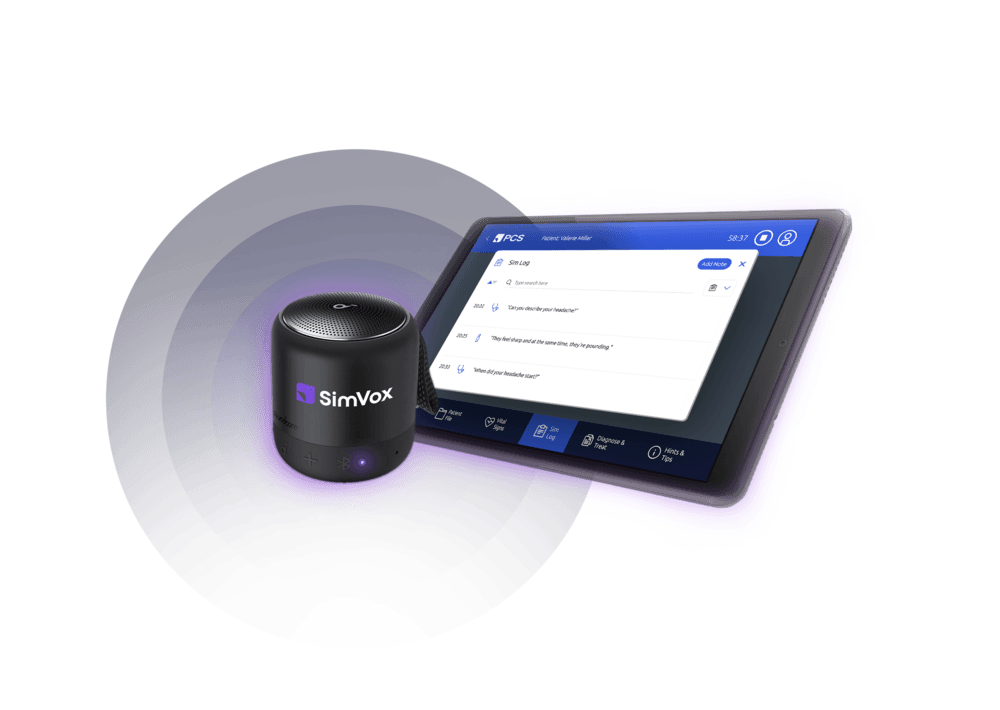Early Adoption of PCS SimVox AI Speaker Deemed Invaluable for FSU
PCS (Patient Communication Simulators) is a simulation technology and software engineering company that has been operating since 2015, specializing solely in healthcare simulation products driven by artificial intelligence (AI). PCS launched their 4th AI-driven product, SimVox in October of 2023. SimVox, the new AI speaker instantly and affordably adds innovative patient communication training technologies to any low-fidelity manikin. This HealthySimulation.com article will explore Florida State University College of Nursing’s purchase and integration of SimVox.
SimVox is a speaker and tablet combo designed with three motives.
- Offer learners enhanced simulation experiences to refine their provider-patient communication skills utilizing generative AI.
- Provide affordable generative AI technology to simulation programs.
- Upcycle and modernize existing simulation assets, such as low-fidelity manikins and task trainers, with the latest technology.
Three Main Takeaways for PCS:
Sponsored Content:
Buying products upon immediate release is not unheard of in the consumer market, but in the healthcare simulation space, this is a much less common practice. Academia’s relationship with funding can be mercurial and complex. But budgets and financial investment aside, educational products must be heavily scrutinized for many reasons, like impact on learners, quality and accuracy, and effectiveness.
Less than two weeks after product launch, on October 12, 2023, Dr. Carla Dormeus, EDD, MS, CHSE, CHSOS, Director of SImulation College of Nursing at Florida State University submitted a purchase order for SimVox. PCS conducted an interview with Dr. Dormeus to determine the catalyst for the purchase, and how they were able to do this along with a list of very candid questions.
- Carla’s strategy for staying current with new technology involves leveraging people. Dr. Dormeus has built a network of vendors who provide direct product briefings, enabling her to access the latest information efficiently. By nurturing relationships and creating a collaborative atmosphere, Carla ensures that she remains informed about emerging technologies throughout the year (or years) between purchasing cycles.
- For FSU College of Nursing, SimVox serves as an invaluable tool that enhances the fidelity of their educational approach, thereby instilling students with the necessary confidence to master essential skills. By incorporating SimVox into their curriculum, the college can provide students with a more immersive and lifelike learning experience, allowing them to practice and refine their skills while remaining in the controlled yet realistic simulation environment. As a result, students emerge from their training with increased confidence in their abilities, better prepared to navigate the challenges they will encounter in their future careers as healthcare professionals.
- Exposure and professional tenure/occupational expertise experience can help one move along the technology adoption curve. As one gains exposure to various technologies and becomes acquainted with their functionalities and applications, they develop a deeper understanding of how these innovations can address specific needs and challenges. This familiarity fosters confidence and reduces apprehension, enabling individuals to embrace new technologies more readily. Experience provides valuable insights into past successes and failures, guiding decision-making processes and refining strategies for effective technology adoption. By leveraging their experience and familiarity with technology, individuals can traverse the adoption curve with greater agility, embracing innovation and driving transformative change within their organizations and communities.
View the LEARN CE/CME Platform Webinar Adding Generative AI to Any Patient Simulator with SimVox Smart Speaker to learn more!
Can an institution in good conscience make a purchase that quickly?
Sponsored Content:
After speaking with Dr. Carla Dormeus directly, PCS thinks this is a feasible option. The first topic discussed was how Carla heard about SimVox. What Carla revealed was a rare approach when considering simulation products and vendors: an open door policy.
We will constantly review everything that comes out to see if it’s a possible product that we can use. I always schedule demos if a vendor wants to stop by, and show it to us. I always open my doors, because you never know what you’re going to learn. Even if the product isn’t a fit for your program, you can still learn something that you might be able to tell someone else. I think we can always learn and network, so it’s beneficial for both sides.
With an open door policy, how do you avoid that feeling of that pressure to purchase something?
It’s part of my job to review these things, but I know I might be a little different. I’m pretty blunt! I tell them, you can show me anything you want. I don’t have any money to spend right now – or I have 20 other priorities – but if your product satisfies our needs, I’ll definitely put it on our to-do list.
We’re very careful in terms of how we spend our money. We have to get the best for the money that we’re investing. It’s hard to convince Deans to buy equipment, especially when we’re talking about thousands of dollars. Even with SimVox, it’s not one of the most expensive products, but it could be expensive for some schools – $7,500 is a lot of money. So, I’m very honest with vendors.
Maintaining a continual assessment of new products is an intriguing strategy, even when the budget is not available at the current time. Many institutions delay product demonstrations until funding has been secured, then engage in rapid and intensive product research.
I agree. I personally think it’s a long-term process. Funding can sometimes move at a turtle’s pace, and then suddenly you have all this money and you have to spend it in a month. You cannot get all the information that you need to make the best decision for your program in a month. So being able to look at certain things throughout the year, over a longer period of time works better for me.
What was the draw to SimVox?
I’ll give you an example because I think you’ll definitely understand since your product doesn’t do this. In other products, when you’re asking the patient a question, you have a drop-down menu with a list of questions you have to choose from. With this menu-based learning, you’re showing the students something that they might not have thought about. It’s not realistic – it’s not a real conversation because you’re giving them some answers, or telling them to go one way versus another. The other problem we found was that many products were cumbersome to use, or it took too many clicks you’re taking time away from having a real conversation and focusing on what the patient’s symptoms are, what questions you should be asking – the things that you will do in a patient encounter.
Read [Blumberg] showed me PCS Spark, I was impressed. I said … you could actually have a conversation with a patient, and you don’t have to pick from drop down menus. SimVox allows you to turn any lower or mid fidelity simulation into a higher fidelity simulation – in terms of communication with the patient. That was it, we need to get at least one.
How are you Implementing or using SimVox?
After having a conversation with a SimVox patient, I started thinking creatively. We could put this on the side table and our nursing students can start having a conversation with the patient while they’re doing the skills, which is realistic. That’s what they’ll do in practice. When you work in the hospital, the patient is not silent most of the time – they’re talking to you. You are supposed to identify them, ask them questions, etc.
One of the hardest parts for our nursing students is talking – how to talk to the patient – makes a difference. When they go to the hospital, they feel more confident. They know the skill, now they know what to say to the patient when they walk into the room.
Before, we were working on the components of patient care separately, now with SimVox, we’re including all the elements that are necessary to make them successful when interacting with patients. So [the students] like it, and the teachers liked it too.
How did you decide on SimVox?
Not only did we request several product demonstrations from different companies, but we were given access to products so we were able to pilot and trial with students ourselves. I think one of the greatest challenges of any Simulation Center is that the products can be very restrictive – and then you start tailoring the curriculum to the restrictions of the product, which is not good. So, we tried products and evaluated their positives and negatives.
Basically, having reviewed so many other products that had so many constraints, and then suddenly getting to this point, where this [SimVox] was so easy to implement, and it brings so many benefits.”
You were the first institution to purchase SimVox… not even 2 weeks after launch!
We had additional lab space, equipment, manikins, and we said, let’s bring it one notch up now, and SimVox came right at the right time – we saw a perfect fit. It was a perfect fit for bringing medium fidelity up to a little more like higher fidelity in terms of communicating with the patient. It fit perfectly into our curriculum, and we didn’t have to change anything. It actually enhanced the experience for the students.
Dr. Dormeus herself on the technology adoption curve, which group would you self-assign?

I’m an Innovator in that sense, but it was a lot of work to get to that point. If you had asked me 15 years ago, I might not have been in that 2.5% in the Early or Late Majority group. For me, [SimVox] was a perfect combination of people who know what they’re doing, and product-fit is a no-brainer. However, if it was a different product, I might have been on the other side of the bell curve, a little more skeptical about certain things. I would have waited, maybe for more development on their end.
Learn More About PCS and Simvox!
Sponsored Content:





















